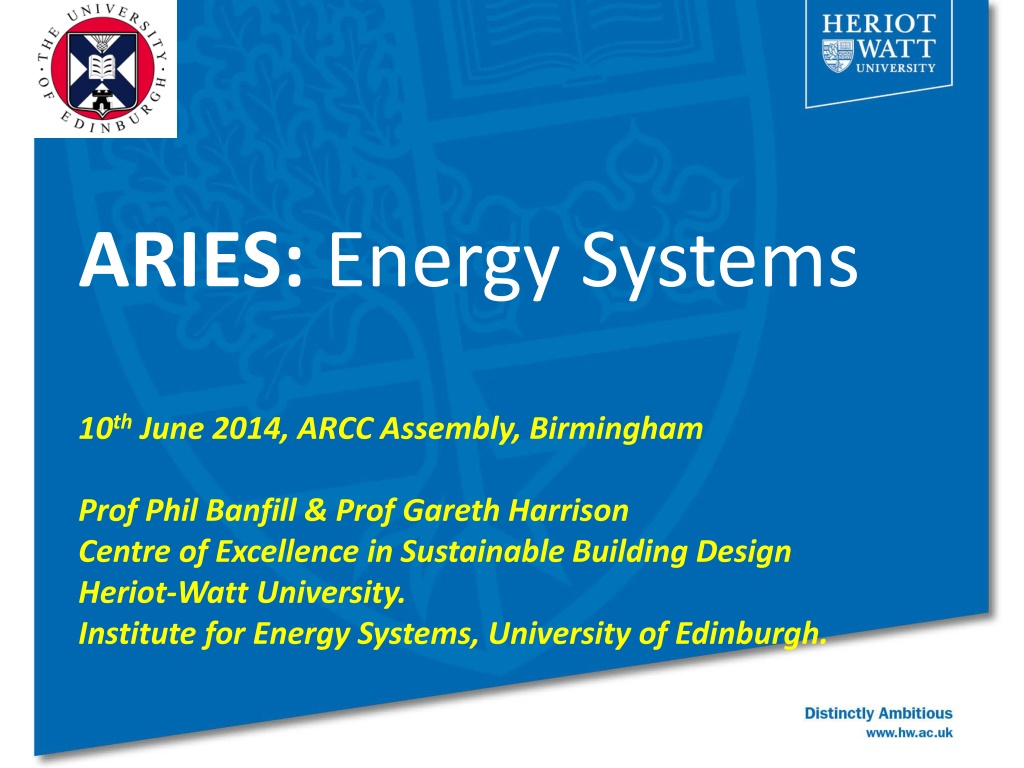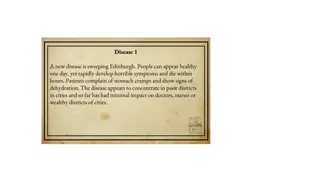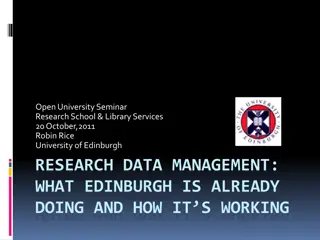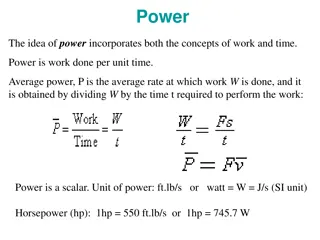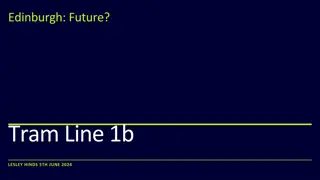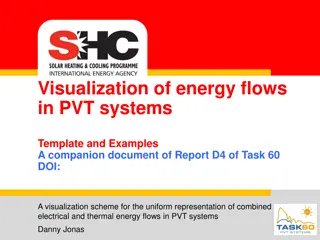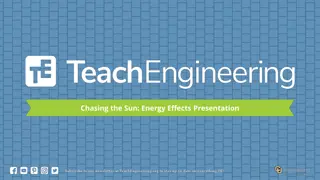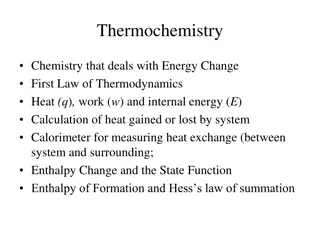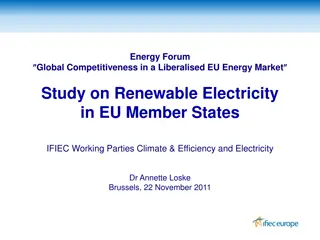ARIES Energy Systems Research at University of Edinburgh and Heriot-Watt University
Explore the ARIES project focusing on energy systems adaptation and resilience at ARCC Assembly. Professors Banfill and Harrison lead the investigation into effects of climate change on energy demand, supply, and infrastructure, addressing challenges like changing energy resources, system shocks, and future scenarios.
Download Presentation

Please find below an Image/Link to download the presentation.
The content on the website is provided AS IS for your information and personal use only. It may not be sold, licensed, or shared on other websites without obtaining consent from the author. Download presentation by click this link. If you encounter any issues during the download, it is possible that the publisher has removed the file from their server.
E N D
Presentation Transcript
ARIES: Energy Systems 10th June 2014, ARCC Assembly, Birmingham Prof Phil Banfill & Prof Gareth Harrison Centre of Excellence in Sustainable Building Design Heriot-Watt University. Institute for Energy Systems, University of Edinburgh.
ARIES Adaptation and Resilience In Energy Systems University of Edinburgh (supply-side) and Heriot-Watt University (demand-side) Modelling the effect of climate and future conditions on energy demand, supply and infrastructure What problems might occur that are caused or exacerbated by climate change?
Change of resource (e.g. wind/tidal/solar) Energy Supply Ability of generation portfolio to react Transmission/ Distribution Effect of climate shocks on system Reduced heating Increased cooling New technologies Change in peak demand Energy Demand
Top-down descriptions Demand-side drivers Energy generation Climate Ensure these complement each other Bottom-up descriptions Building stock Behaviour HVAC tech Micro-gen
The effect of future scenarios on demand: Power demand over a 24 hour period Current 00:00 02:00 04:00 06:00 08:00 10:00 12:00 14:00 16:00 18:00 20:00 22:00 00:00
Energy efficient lighting, e.g. LED ? Current Future 1 00:00 02:00 04:00 06:00 08:00 10:00 12:00 14:00 16:00 18:00 20:00 22:00 00:00
Charge cycle of electric vehicles? Current Future 1 Future 2 00:00 02:00 04:00 06:00 08:00 10:00 12:00 14:00 16:00 18:00 20:00 22:00 00:00
Continuing rise in consumer electronics? Current Future 1 Future 2 Future 3 00:00 02:00 04:00 06:00 08:00 10:00 12:00 14:00 16:00 18:00 20:00 22:00 00:00
Continuing rise in consumer electronics? Climate Change? 00:00 02:00 04:00 06:00 08:00 10:00 12:00 14:00 16:00 18:00 20:00 22:00 00:00
For this we need quite specific scenarios... Archetypes of dwellings Scottish Building Stock from Housing Surveys, and how these might change in the future Apply these scenarios to zones of 500-6000 homes Such bottom-up scenarios do not necessarily need to be paired with top-down scenarios But we need to make sure they do not clash with them e.g. avoid high heat pump usage in higher grid carbon intensity scenarios
How can we synthesize electrical demand profiles? Individual dwelling demand profiles show a clear link with activity and technologies Multi-dwelling demand profiles show periods of interest/concern for an energy supplier Can a method utilise both of the above? And demonstrate the effect of changing specific parameters on aggregated demand profiles Particularly a challenge as high-resolution dwelling demand profiles are difficult to obtain in great number
Synthesizing electrical demand profiles Small number of real dwelling profiles Synthetic profile generator (using Hidden Markov Modelling) Aggregated multi- dwelling profile n x individual dwelling synthetic profiles 7 7 6 6 5 Demand per dwelling (kW) 5 Electrical Demand (kW) 4 4 3 3 2 2 1 1 0 0 00:00 02:00 04:00 06:00 08:00 10:00 12:00 14:00 16:00 18:00 20:00 22:00 00:00 00:00 01:00 02:00 03:00 04:00 05:00 06:00 07:00 08:00 09:00 10:00 11:00 12:00 13:00 14:00 15:00 16:00 17:00 18:00 19:00 20:00 21:00 22:00 23:00
Diversity effect in electrical demand profiles 7 6 5 Demand per dwelling (kW) 4 Single dwelling 9 dwellings 3 45 dwellings (synthetic) 90 dwellings (synthetic) 2 1 0 00:00 02:00 04:00 06:00 08:00 10:00 12:00 14:00 16:00 18:00 20:00 22:00 00:00
Aggregated thermal demand profiles Developed a method for dynamically simulating large numbers of dwellings (in IES-VE) In effect, a Dynamic Local-Scale Stock model (DLSSM) Accounts for important aspects of building physics but in a way that is suitable for extrapolation Can look at effect of, e.g., large-scale changes in heating technology (in a warmer climate)
A local scale stock model Zones of Semi-dets, Dets, Terraces, Mid-terraces, Flats, etc Zones of 1919-64, 1965-76, 1977-2002, etc Building variants created and adjusted by floor area, % glazing, wall construction.
Processing Information 100% 90% 80% Thermal demand 70% 60% SemiD 50% MidT 40% Flat 30% EndT 20% Detached 10% 0% 00:05 01:25 04:05 05:25 06:45 Time of Day (hh:mm) 21st Jan 09:25 10:45 12:05 14:45 16:05 17:25 20:05 21:25 22:45 02:45 08:05 13:25 18:45
The Supply Side Wide range of generation technologies commercially available now and even wider range by 2050 These have diverse operational characteristics and response to changing climate need to capture these robustly Spatial pattern of generation deployment is important in credible scenarios resource, economics, grid connection all have strong influence
E.G. Solar Radiation / PV Output Baseline, relative change, and percentage change (from baseline) for 2050s medium emissions scenario with 50% probability Baseline - Summer months 2050s Medium Emissions 50% probability change (Wm-2) Summer months 2050s Medium Emissions 50% probability change (%) Summer months 18
The Supply Side Wave Power time Wind Power time Wave Power Solar Power time time
The Supply Side Capacity Technology and match with demand Capacity Power Technology Capacity Capacity Technology Technology
In conclusion we have... An approach for modelling an aggregated thermal demand profile for a selection of buildings A method for upscaling individual dwelling electrical demands to aggregated demands A tool emulating the effect of climate on building simulations A model for estimating the effect of climate on electricity transmission Method demonstrating the effect of climate on renewable generation Wind, Solar, Hydro, Tidal, Wave
Non-Domestic Building typology (e.g. new build and retrofit targets) Offsite generation (e.g. % renewables) Grid C.I. kgCO2/kWh Micro-gen (e.g. solar panels) Working patterns (e.g. home- working) Domestic non-heating (e.g. consumer electronics growth) Non-domestic heating (e.g. boiler tech) Climate scenarios (e.g. UKCP 09) Domestic heating (e.g. heat pumps) Non-domestic non-heating (e.g. IT usage/tech) Domestic Building typology (e.g. new build and retrofit targets) Transport (e.g. elec vehicles) Infrastructure/ transmission (e.g. cables/wires, LV transformers) Climate Demand-side Supply/distribution-side
So now we just have to put them all together!! P.F.G.Banfill@hw.ac.uk Gareth.Harrison@ed.ac.uk
